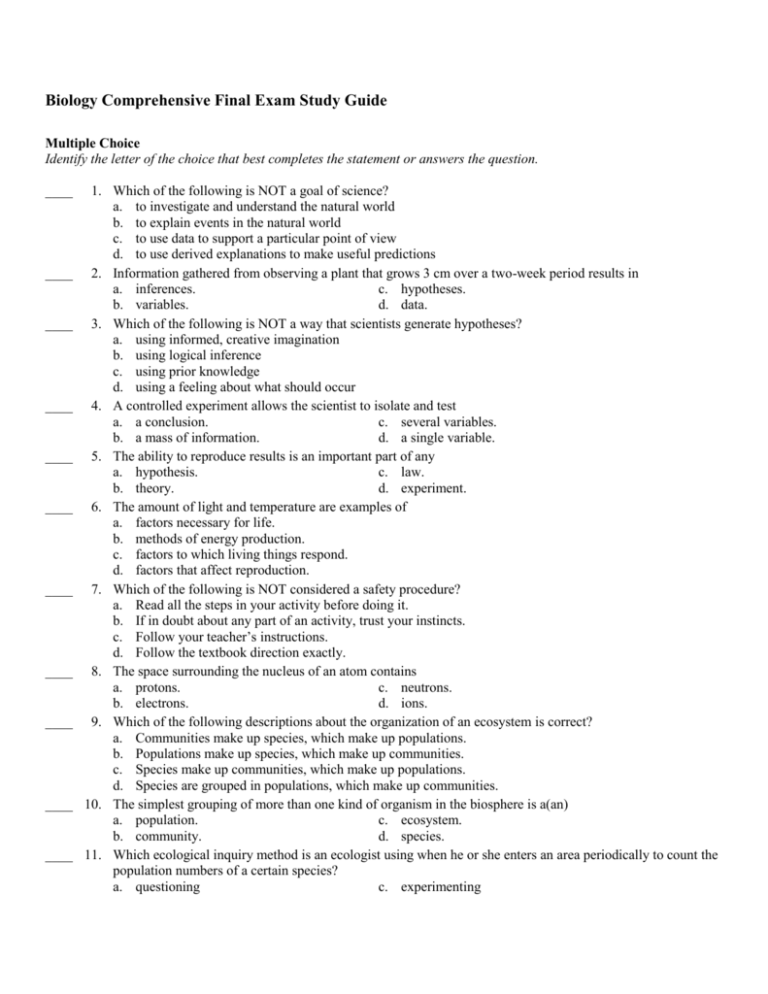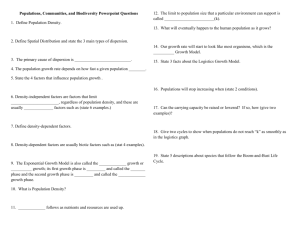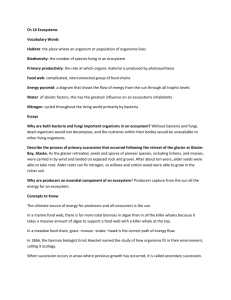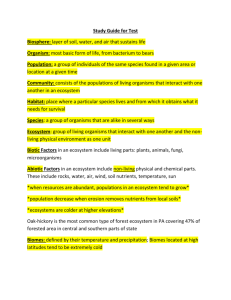Biology Study Guide
advertisement

Biology Comprehensive Final Exam Study Guide Multiple Choice Identify the letter of the choice that best completes the statement or answers the question. ____ ____ ____ ____ ____ ____ ____ ____ ____ ____ ____ 1. Which of the following is NOT a goal of science? a. to investigate and understand the natural world b. to explain events in the natural world c. to use data to support a particular point of view d. to use derived explanations to make useful predictions 2. Information gathered from observing a plant that grows 3 cm over a two-week period results in a. inferences. c. hypotheses. b. variables. d. data. 3. Which of the following is NOT a way that scientists generate hypotheses? a. using informed, creative imagination b. using logical inference c. using prior knowledge d. using a feeling about what should occur 4. A controlled experiment allows the scientist to isolate and test a. a conclusion. c. several variables. b. a mass of information. d. a single variable. 5. The ability to reproduce results is an important part of any a. hypothesis. c. law. b. theory. d. experiment. 6. The amount of light and temperature are examples of a. factors necessary for life. b. methods of energy production. c. factors to which living things respond. d. factors that affect reproduction. 7. Which of the following is NOT considered a safety procedure? a. Read all the steps in your activity before doing it. b. If in doubt about any part of an activity, trust your instincts. c. Follow your teacher’s instructions. d. Follow the textbook direction exactly. 8. The space surrounding the nucleus of an atom contains a. protons. c. neutrons. b. electrons. d. ions. 9. Which of the following descriptions about the organization of an ecosystem is correct? a. Communities make up species, which make up populations. b. Populations make up species, which make up communities. c. Species make up communities, which make up populations. d. Species are grouped in populations, which make up communities. 10. The simplest grouping of more than one kind of organism in the biosphere is a(an) a. population. c. ecosystem. b. community. d. species. 11. Which ecological inquiry method is an ecologist using when he or she enters an area periodically to count the population numbers of a certain species? a. questioning c. experimenting b. observing d. modeling Figure 3-1 ____ 12. The algae at the beginning of the food chain in Figure 3-1 are a. consumers. c. producers. b. decomposers. d. heterotrophs. ____ 13. An organism that uses energy to produce its own food supply from inorganic compounds is called a(an) a. heterotroph. c. detritivore. b. consumer. d. autotroph. ____ 14. Which of the following organisms does NOT require sunlight to live? a. chemosynthetic bacteria c. trees b. algae d. photosynthetic bacteria ____ 15. The total amount of living tissue within a given trophic level is called the a. organic mass. c. energy mass. b. trophic mass. d. biomass. ____ 16. What animals eat both producers and consumers? a. herbivores c. chemotrophs b. omnivores d. autotrophs ____ 17. A snake that eats a frog that has eaten an insect that fed on a plant is a a. first-level producer. c. second-level producer. b. first-level consumer. d. third-level consumer. ____ 18. Only 10 percent of the energy stored in an organism can be passed on to the next trophic level. Of the remaining energy, some is used for the organism’s life processes, and the rest is a. used in reproduction. c. stored as fat. b. stored as body tissue. d. eliminated as heat. ____ 19. What is the process by which bacteria convert nitrogen gas in the air to ammonia? a. nitrogen fixation c. decomposition b. excretion d. denitrification ____ 20. Carbon cycles through the biosphere in all of the following processes EXCEPT a. photosynthesis. c. respiration. b. transpiration. d. decomposition. ____ 21. The movements of energy and nutrients through living systems are different because a. energy flows in one direction and nutrients recycle. b. energy is limited in the biosphere and nutrients are always available. c. nutrients flow in one direction and energy recycles. d. energy forms chemical compounds and nutrients are lost as heat. ____ 22. Which is most likely to be a limiting nutrient in a freshwater pond? a. phosphorus c. carbon b. nitrogen d. potassium ____ 23. Climate is a global factor that produces a. Earth’s unique ocean and atmosphere. b. the shape and elevation of landmasses. c. a wide range of environmental conditions that shapes communities. d. solar energy within the atmosphere. ____ 24. The loss of heat to space is slowed by a. radiation entering the atmosphere. c. solar energy. b. atmospheric gases. d. the biosphere. ____ 25. Earth has three main climate zones because of the differences in latitude and a. amount of solar energy received. c. ocean currents. b. angle of heating. d. prevailing winds. ____ 26. The unequal heating of Earth’s surface a. drives wind and ocean currents. b. causes winds that transport heat throughout the biosphere. c. has important effects on Earth’s climate regions. d. all of the above ____ 27. Which is a biotic factor that affects the size of a population in a specific ecosystem? a. average temperature of the ecosystem b. type of soil in the ecosystem c. number and kinds of predators in the ecosystem d. concentration of oxygen in the ecosystem ____ 28. Several species of warblers can live in the same spruce tree ONLY because they a. have different habitats within the tree. b. eat different foods within the tree. c. occupy different niches within the tree. d. can find different temperatures within the tree. ____ 29. Different species can share the same habitat, but competition among them is reduced if they a. reproduce at different times. c. increase their populations. b. eat less. d. occupy different niches. ____ 30. The symbiotic relationship between a flower and the insect that feeds on its nectar is an example of a. mutualism because the flower provides the insect with food, and the insect pollinates the flower. b. parasitism because the insect lives off the nectar from the flower. c. commensalism because the insect doesn’t harm the flower, and the flower doesn’t benefit from the relationship. d. predation because the insect feeds on the flower. ____ 31. What is one difference between primary and secondary succession? a. Primary succession is slow, and secondary succession is rapid. b. Secondary succession begins on soil, and primary succession begins on newly exposed surfaces. c. Primary succession modifies the environment, and secondary succession does not. d. Secondary succession begins with lichens, and primary succession begins with trees. ____ 32. Which factor can influence continual change in an ecosystem? a. further disturbances c. introduction of nonnative species b. long-term climate changes d. all of the above ____ 33. An example of a place with a microclimate is a. a mountain range capped with ice. b. a forested park in a desert city. c. an orchid growing in a rain forest. ____ 34. ____ 35. ____ 36. ____ 37. ____ 38. ____ 39. ____ 40. ____ 41. ____ 42. ____ 43. ____ 44. d. coniferous trees in a temperate forest. Which two biomes have the least amount of precipitation? a. tropical rain forest and temperate grassland b. tropical savanna and tropical dry forest c. tundra and desert d. boreal forest and temperate woodland and shrubland The chemistry of aquatic ecosystems is determined by the a. amount of salts, nutrients, and oxygen dissolved in the water. b. number of other organisms present in the water. c. amount of rainfall the water receives. d. biotic and abiotic factors in the water. Which is NOT an adaptation that organisms have for living in flowing water? a. hooks c. streamlined bodies b. tentacles d. suckers Which of the following statements is NOT true about the oceanic zone? a. The open ocean has very low levels of nutrients. b. Organisms in the deep oceanic zone are exposed to frigid temperatures and total darkness. c. The oceanic zone begins at the low-tide mark and extends to the end of the continental shelf. d. Most of the photosynthetic activity on Earth occurs in the open ocean within the photic zone. What can cause a population to grow? a. The birthrate becomes higher than the death rate. b. The birthrate stays the same, and the death rate increases. c. The birthrate becomes lower than the death rate. d. The birthrate and the death rate remain the same. Which are two ways a population can decrease in size? a. immigration and emigration b. increased death rate and immigration c. decreased birthrate and emigration d. emigration and increased birthrate As resources in a population become less available, population growth a. becomes negative. b. increases slowly. c. reaches carrying capacity. d. enters a phase of exponential growth. Which of the following is not likely to be a limiting factor on the sea otter population? a. disease c. drought b. competition d. predation Which will reduce competition within a species’ population? a. fewer individuals c. fewer resources b. higher birthrate d. higher population density If a population grows larger than the carrying capacity of the environment, the a. death rate may rise. c. population will grow faster. b. birthrate may rise. d. carrying capacity will change. Which would be least likely to be affected by a density-dependent limiting factor? a. a small, scattered population b. a population with a high birthrate c. a large, dense population ____ 45. ____ 46. ____ 47. ____ 48. ____ 49. ____ 50. ____ 51. ____ 52. ____ 53. ____ 54. ____ 55. ____ 56. ____ 57. d. a population with a high immigration rate The work of Schleiden and Schwann can be summarized by saying that a. all plants are made of cells. b. all animals are made of cells. c. plants and animals have specialized cells. d. all plants and animals are made of cells. Which cell structure contains the cell’s genetic material and controls many of the cell’s activities? a. organelle c. cell envelope b. nucleus d. cytoplasm Cells fall into two broad categories, depending on whether they a. have a cell wall. c. have a nucleus. b. contain genetic material. d. contain chloroplasts. Eukaryotes usually contain a. a nucleus. c. genetic material. b. specialized organelles. d. all of the above Which of the following is NOT found in the nucleus? a. cytoplasm c. chromatin b. nucleolus d. DNA Which structures carry out cell movement? a. cytoplasm and ribosomes b. nucleolus and nucleus c. microtubules and microfilaments d. chromosomes Which organelle breaks down compounds into small particles that the cell can use? a. Golgi apparatus c. endoplasmic reticulum b. lysosome d. mitochondrion Which organelle makes proteins using coded instructions that come from the nucleus? a. Golgi apparatus c. vacuole b. mitochondrion d. ribosome Which organelle converts the chemical energy stored in food into compounds that are more convenient for the cell to use? a. chloroplast c. endoplasmic reticulum b. Golgi apparatus d. mitochondrion Which of the following is a function of the cell membrane? a. breaks down lipids, carbohydrates, and proteins from foods b. stores water, salt, proteins, and carbohydrates c. keeps the cell wall in place d. regulates which materials enter and leave the cell Diffusion occurs because a. molecules constantly move and collide with one another. b. the concentration of a solution is never the same throughout a solution. c. the concentration of a solution is always the same throughout a solution. d. molecules never move or collide with one another. An animal cell that is surrounded by fresh water will burst because the osmotic pressure causes a. water to move into the cell. c. solutes to move into the cell. b. water to move out of the cell. d. solutes to move out of the cell. The cells of multicellular organisms are a. smaller than those of unicellular organisms. ____ 58. ____ 59. ____ 60. ____ 61. ____ 62. b. simpler than those of unicellular organisms. c. specialized to perform particular functions. d. not dependent on one another. Which of the following is an organ of the digestive system? a. stomach c. muscle cell b. nerve tissue d. epithelial tissue An organ system is a group of organs that a. are made up of similar cells. b. are made up of similar tissues. c. work together to perform a specific function. d. work together to perform all the functions in a multicellular organism. Which of the following is an autotroph? a. mushroom c. monkey b. dog d. tree Which of the following is NOT an example of a heterotroph? a. mushroom c. grass b. leopard d. human Energy is released from ATP when a. a phosphate group is added. c. ATP is exposed to sunlight. b. adenine bonds to ribose. d. a phosphate group is removed. Figure 8–1 ____ 63. Look at Figure 8-1. All of the following are parts of an ADP molecule EXCEPT a. structure A. c. structure C. b. structure B. d. structure D. ____ 64. Which structures shown in Figure 8-1 make up an ATP molecule? a. A and B c. A, B, C, and D b. A, B, and C d. C and D ____ 65. Which of the following are used in the overall reactions for photosynthesis? a. carbon dioxide c. light b. water d. all of the above ____ 66. Most plants appear green because chlorophyll a. does not absorb green light. c. absorbs green light. b. reflects violet light. d. none of the above ____ 67. If carbon dioxide is removed from a plant’s environment, what would you expect to happen to its production of high-energy sugars? ____ 68. ____ 69. ____ 70. ____ 71. ____ 72. ____ 73. ____ 74. ____ 75. ____ 76. ____ 77. ____ 78. ____ 79. a. More sugars will be produced. b. No sugars will be produced. c. The same number of sugars will be produced but without carbon dioxide. d. Carbon dioxide does not affect the production of high-energy sugars in plants. If you continue to increase the intensity of light that a plant receives, what happens? a. The rate of photosynthesis increases with light intensity. b. The rate of photosynthesis decreases with light intensity. c. The rate of photosynthesis increases and then levels off. d. The rate of photosynthesis does not change. What are the reactants in the equation for cellular respiration? a. oxygen and lactic acid c. glucose and oxygen b. carbon dioxide and water d. water and glucose One cause of muscle soreness is a. alcoholic fermentation. c. lactic acid fermentation. b. glycolysis. d. the Krebs cycle. Which process is used to produce beer and wine? a. lactic acid fermentation c. alcoholic fermentation b. glycolysis d. the Krebs cycle Breathing heavily after running a race is your body’s way of a. making more citric acid. b. repaying an oxygen debt. c. restarting glycolysis. d. recharging the electron transport chain. Photosynthesis is to chloroplasts as cellular respiration is to a. chloroplasts. c. mitochondria. b. cytoplasm. d. nucleus. As a cell becomes larger, its a. volume increases faster than its surface area. b. surface area increases faster than its volume. c. volume increases, but its surface area stays the same. d. surface area stays the same, but its volume increases. Which event occurs during interphase? a. The cell grows. b. Centrioles appear. c. Spindle fibers begin to form. d. Centromeres divide. During which phase of mitosis do the chromosomes line up along the middle of the dividing cell? a. prophase c. metaphase b. telophase d. anaphase Which of the following represents the phases of mitosis in their proper sequence? a. prophase, metaphase, anaphase, telophase b. interphase, prophase, metaphase, anaphase, telophase c. interphase, prophase, metaphase, telophase d. prophase, metaphase, anaphase, telophase, cytokinesis What is the role of the spindle during mitosis? a. It helps separate the chromosomes. c. It duplicates the DNA. b. It breaks down the nuclear membrane. d. It divides the cell in half. Cancer is a disorder in which some cells have lost the ability to control their a. size. c. growth rate. ____ 80. ____ 81. ____ 82. ____ 83. ____ 84. b. spindle fibers. d. surface area. The principles of probability can be used to a. predict the traits of the offspring produced by genetic crosses. b. determine the actual outcomes of genetic crosses. c. predict the traits of the parents used in genetic crosses. d. decide which organisms are best to use in genetic crosses. A Punnett square shows all of the following EXCEPT a. all possible results of a genetic cross. b. the genotypes of the offspring. c. the alleles in the gametes of each parent. d. the actual results of a genetic cross. How many different allele combinations would be found in the gametes produced by a pea plant whose genotype was RrYY? a. 2 c. 8 b. 4 d. 16 If an organism’s diploid number is 12, its haploid number is a. 12. c. 24. b. 6. d. 3. What is shown in Figure 11-1? Figure 11–1 ____ 85. ____ 86. ____ 87. ____ 88. a. independent assortment c. crossing-over b. anaphase I of meiosis d. incomplete dominance Unlike mitosis, meiosis results in the formation of a. two genetically identical diploid cells. b. four genetically different haploid cells. c. four genetically identical haploid cells. d. two genetically different diploid cells. Unlike DNA, RNA contains a. adenine. c. phosphate groups. b. uracil. d. thymine. How many codons are needed to specify three amino acids? a. 3 c. 9 b. 6 d. 12 Scientists assign each kind of organism a universally accepted name in the system known as a. traditional classification. c. binomial nomenclature. b. the three domains. d. cladistics. ____ 89. For many species, there are often regional differences in their a. common names. c. taxa. b. scientific names. d. binomial nomenclature. ____ 90. The second part of a scientific name is unique to each a. order in its class. c. genus in its family. b. family in its order. d. species in its genus. ____ 91. Several different classes make up a a. kingdom. c. family. b. phylum. d. genus. ____ 92. Which two kingdoms did Linnaeus recognize? a. bacteria and animals c. plants and animals b. plants and fungi d. protists and animals ____ 93. Traditional classifications tended to take into account primarily a. extinct organisms. c. DNA similarities. b. RNA similarities. d. general similarities in appearance. ____ 94. Sometimes organisms that are not closely related look similar because of a. convergent evolution. c. mutations. b. molecular clocks. d. reclassification. ____ 95. In an evolutionary classification scheme, species within one genus should a. be more similar to each other than they are to other species. b. not be similar in appearance. c. be limited to species that can interbreed. d. have identical genes. ____ 96. Which of the kingdoms in the six-kingdom system of classification was once grouped with plants? a. Animalia c. Fungi b. Carnivores d. Protista ____ 97. Organisms in the kingdoms Eubacteria and Archaebacteria were previously grouped in a kingdom called a. Animalia. c. Monera. b. Fungi. d. Eukarya.









